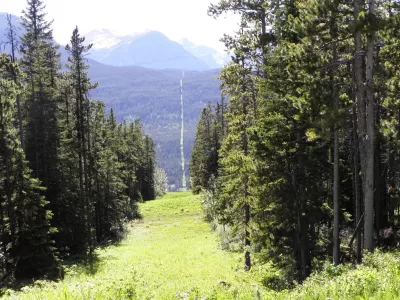International borders viewed from above show how different patterns of political, urban and agricultural development often collide.

Can you identify two countries, side-by-side, just by their urban and agricultural patterns of development? As Emily Gilbert writes in Medium, viewing international borders from above can provide visual evidence of starkly different levels of economic and political systems. Farming practices on either side of the border between Haiti and the Dominican Republic give cues about the wealth disparities between the two neighboring countries.
Using satellite images, Gilbert also notes the inventive infrastructural changes needed when two countries meet where road rules require drivers to switch what side of the road they drive on, such as the switch-over between Hong Kong and mainland China.
At borders, different laws, politics, and cultures come together. These disparities can manifest in many ways we can see from space. Countries can regulate many aspects of our daily lives, including one of the most mundane parts — our daily commutes. Different nations have different laws about which side of the road we drive on. We can see several instances where these laws change over borders, and it is interesting to look at the inventive infrastructure that has been developed to handle the lane switch.
FULL STORY: Border Post: Seeing Boundaries from Space

Maui's Vacation Rental Debate Turns Ugly
Verbal attacks, misinformation campaigns and fistfights plague a high-stakes debate to convert thousands of vacation rentals into long-term housing.

Planetizen Federal Action Tracker
A weekly monitor of how Trump’s orders and actions are impacting planners and planning in America.

San Francisco Suspends Traffic Calming Amidst Record Deaths
Citing “a challenging fiscal landscape,” the city will cease the program on the heels of 42 traffic deaths, including 24 pedestrians.

Defunct Pittsburgh Power Plant to Become Residential Tower
A decommissioned steam heat plant will be redeveloped into almost 100 affordable housing units.

Trump Prompts Restructuring of Transportation Research Board in “Unprecedented Overreach”
The TRB has eliminated more than half of its committees including those focused on climate, equity, and cities.

Amtrak Rolls Out New Orleans to Alabama “Mardi Gras” Train
The new service will operate morning and evening departures between Mobile and New Orleans.
Urban Design for Planners 1: Software Tools
This six-course series explores essential urban design concepts using open source software and equips planners with the tools they need to participate fully in the urban design process.
Planning for Universal Design
Learn the tools for implementing Universal Design in planning regulations.
Heyer Gruel & Associates PA
JM Goldson LLC
Custer County Colorado
City of Camden Redevelopment Agency
City of Astoria
Transportation Research & Education Center (TREC) at Portland State University
Jefferson Parish Government
Camden Redevelopment Agency
City of Claremont


























